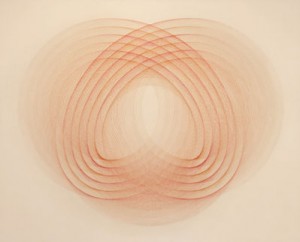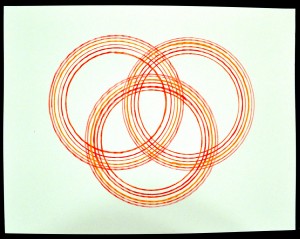GENERATING GEOMETRIES: EDUARDO MAC ENTYRE’S SEIS FORMAS EN DOS CIRCUNFERENCIAS
 |
 |
Trained in technical drawing, Eduardo Mac Entyre (b. 1929) began to explore different variations and arrangements of the curved line in his paintings during the 1950s. In 1959, Mac Entyre co-founded the group Arte Generativo (“Generative Art”) with the artist Miguel Angel Vidal, aspiring to produce art that was both spiritual and abstract. He later worked in different styles but remains best known for his contributions to Geometric Abstraction in Latin America.
Painted by Argentine artist Eduardo Mac Entyre in 1966, Seis formas en dos circunferencias (Six Forms in Two Circumferences) draws upon basic geometric forms to create an image that vibrates with movement, color, and light. The painting is a prime example of Generative Art, a trend that emerged within the tradition of Geometric Abstraction in Latin America during the 1960s.
Mac Entyre based his practice around the circumference, or enclosing boundary, of a circle, which he considered the purest expression of movement. A perfect geometric shape, the circle conveys balance and unity, bringing into harmony the transcendental experience of the universe (circles are found everywhere in nature) and the intellectual precision of geometry. Mac Entyre’s Generative paintings begin with the point and the line, which through a series of interventions become circles that pulse with vitality. The finely drawn red and orange lines of Seis formas en dos circunferencias suggest the dynamic energy and luminosity of geometry in motion.
Geometric Abstraction is a form of abstract art based on the use of simple, geometric forms such as the circle and the square. Developed out of ideas and, sometimes, mathematical formulas, Geometric Abstraction does not seek to represent recognizable objects or figures from the “real world.” The movement first developed in Europe and in Russia in the first decades of the twentieth century, but it gained new momentum in Latin America during the 1950s and 1960s. In Argentina and elsewhere, Geometric Abstraction was felt to convey values of freedom and hope during times of political upheaval and disorder.
What makes Mac Entyre’s painting art? Consider the creative choices that Mac Entyre made in Seis formas en dos circunferencias as you begin to plan your own Generative artwork. How do variations in the color, shape, and size of the circles affect the overall visual impact of the finished work?
You will need:
- A compass
- Colored pencils or pens
- Paper
- A piece of cardboard bigger than your paper (to protect your work surface)
- A ruler (optional)
Mac Entyre and another Argentine artist, Miguel Angel Vidal (1928-2009), founded the Generative Art (“Arte Generativo”) movement in 1959. Ary Brizzi (b. 1930) later became the third member of the group. A type of Geometric Abstraction, Generative Art explores the intangible, universal dimensions of geometric forms, attempting to update earlier ideals of beauty for an increasingly technological age. Each of these artists explored the ways in which basic geometric forms – the circle, the square, the line – can be repeated, transformed, or varied to produce more profound visual effects.
Step 1. Select the colors. The circles can be drawn in a single color, in two colors (like Seis formas en dos circunferencias), or in a rainbow of colors.
Step 2. Insert a colored pencil or pen into the compass and extend the hinge outward to determine the circumference of the circle. With a piece of paper centered on the cardboard, stick the pointed end (the needle) of the compass into the paper, piercing the cardboard, and carefully move the pencil or pen to trace the shape of a circle.
Step 3. Without changing the range of the compass, draw a second circle that intersects with the first circle. This circle should have the same circumference as the first circle.
Step 4. Repeat Steps 2 and 3 with different colors and combinations of colors. Change the circumference of the circle by adjusting the range of the compass. The closer the concentric circles are in diameter, the more they will seem to perceptually vibrate, or move, on the paper. Continue to experiment with different colors, and even different shapes (an ellipse, for example, or a square).
External links:
Generative Art can also be made with a spirograph, a tool that creates patterns based on the circle. Spirographs are commercially available and most suitable for younger aspiring artists.
- Eduardo Mac Entyre’s official website, in Spanish, shows a number of his Generative paintings (click on “Obras,” then on “Arte Generativo”).
- Describing Nature with Math – This website includes a lot of information about how scientists use math to describe nature and define reality. Follow this link to find out how we use math to determine everything from the mass of our planet to the number of seeds in a sunflower.
- Circles, Circles Everywhere – This University of Cambridge affiliated website explores some of the most famous and mysterious circles in history and why humans are so fascinated with this shape.
Lesson plan by Caroline J. Dubinsky. Photo credits: Art Museum of the Americas, Caroline J. Dubinsky.




